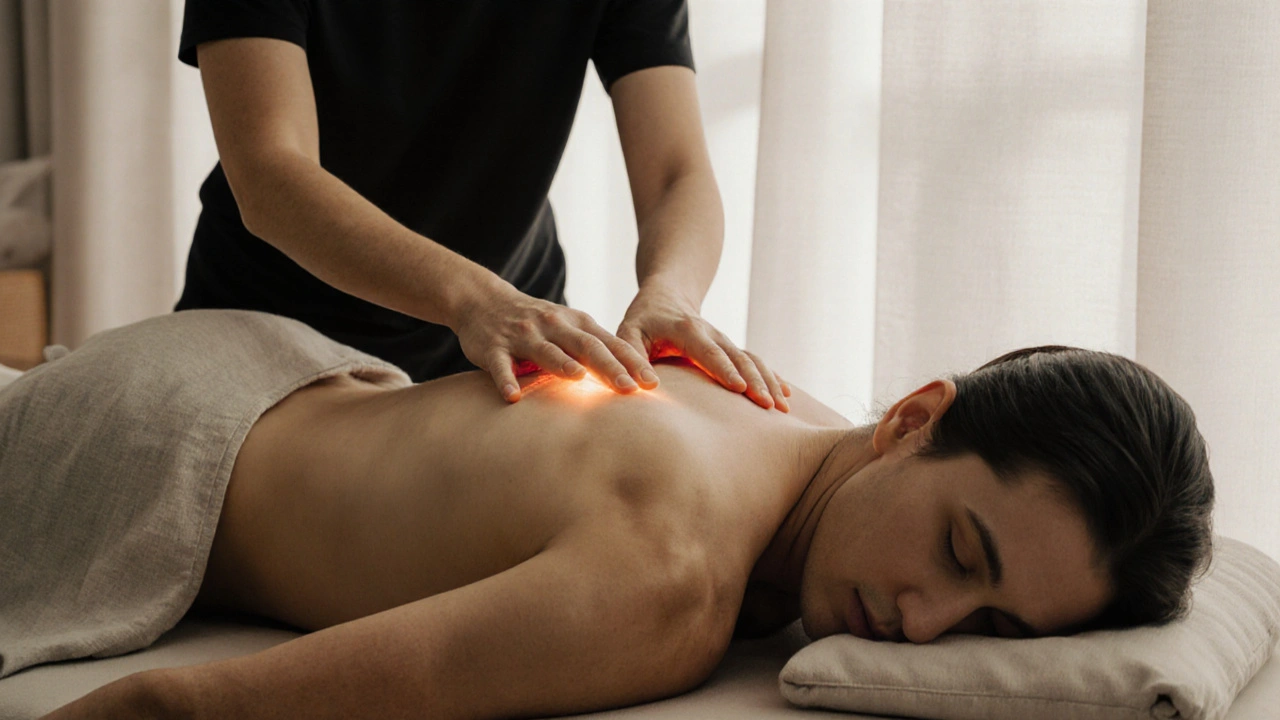Myofascial Release Therapy: How It Relieves Chronic Pain and Restores Movement
 Oct, 28 2025
Oct, 28 2025
Myofascial Release Benefit Estimator
This tool helps determine if myofascial release therapy may benefit your specific pain pattern based on clinical guidelines and research.
Ever feel like your muscles are locked in a vice, even after a good stretch or massage? You might not be dealing with a strained muscle-you could be fighting tight fascia. Myofascial release therapy isn’t just another spa treatment. It’s a hands-on technique that targets the connective tissue wrapping your muscles, and for millions with chronic pain, it’s the missing piece they’ve been searching for.
What Exactly Is Fascia?
Fascia is the invisible webbing that holds your body together. It’s a continuous layer of connective tissue that surrounds every muscle, bone, nerve, blood vessel, and organ. Think of it like plastic wrap tightly wrapped around a bundle of cables-except in your body, this wrap is meant to slide and stretch. When fascia gets stuck, dried out, or scarred from injury, surgery, or even long-term poor posture, it pulls on muscles and nerves. That’s when pain shows up-not just where you feel it, but often far away from the real source.
People with myofascial pain syndrome often describe it as deep, aching, or burning. The pain doesn’t follow nerve paths like sciatica. Instead, it radiates in strange patterns: lower back pain that shoots into the thigh, headaches that start at the base of the skull, or shoulder pain that makes it hard to reach overhead. Traditional massage might feel good temporarily, but if the fascia is still stuck, the pain comes back.
How Myofascial Release Therapy Works
Myofascial release therapy uses sustained, gentle pressure-usually with the hands, elbows, or specialized tools-to stretch and soften the restricted fascia. Unlike deep tissue massage, which targets muscle fibers with force, myofascial release works slowly. Therapists hold pressure on a tight spot for 90 to 120 seconds, waiting for the tissue to release on its own. This isn’t about breaking through pain; it’s about inviting the tissue to relax.
The science behind it is simple: fascia contains sensory nerves and collagen fibers that respond to slow, steady pressure. When held long enough, these fibers begin to unwind. Blood flow increases. Inflammation decreases. And the body starts to remember how to move without restriction.
One 2023 study tracking 120 patients with chronic lower back pain found that after six weeks of weekly myofascial release sessions, 78% reported at least a 50% reduction in pain levels. No drugs. No injections. Just hands-on work.
Common Conditions That Respond to Myofascial Release
This therapy isn’t a cure-all, but it’s proven effective for several stubborn conditions:
- Chronic headaches and migraines-tight fascia in the neck and jaw can pull on the scalp and trigger pain.
- Fibromyalgia-while the cause is complex, many patients report less widespread tenderness after consistent release work.
- Tennis elbow and plantar fasciitis-both involve inflamed fascia, not just tendons.
- Post-surgical scarring-scar tissue binds fascia. Release therapy can help restore mobility after surgeries like C-sections or knee replacements.
- TMJ disorders-tightness in the fascia around the jaw can cause clicking, pain, and even earaches.
It’s not just for athletes or older adults. Office workers with hunched shoulders, new moms with tight chests from breastfeeding, and even teenagers with posture-related neck pain all benefit.
What to Expect During a Session
A typical session lasts 60 to 90 minutes. You’ll lie on a table, fully clothed in loose, comfortable clothing. The therapist won’t use oil or lotion-they need to grip the skin and fascia directly. There’s no cracking or popping. No intense pressure that makes you gasp.
Instead, you’ll feel a deep, sometimes uncomfortable stretch-like the sensation of pulling a tight rubber band. It’s not supposed to hurt, but it should feel like something is releasing. Many people report feeling warmth, tingling, or even emotional release during sessions. It’s normal.
Afterward, you might feel a little sore, like after a good workout. That’s your body adjusting. Drink water. Move gently. Avoid heavy lifting or intense exercise for 24 hours. Your fascia needs time to reorganize.

Can You Do It Yourself?
Yes-but with limits. Tools like foam rollers, massage balls, and lacrosse balls can help maintain progress between professional sessions. Rolling your back over a foam roller for 10 minutes a day can ease tension in the thoracic spine. A tennis ball pressed against the sole of your foot can help with plantar fasciitis.
But self-release has boundaries. You can’t reach every tight spot. You won’t know if you’re applying enough pressure or holding long enough. And if you have a recent injury, nerve damage, or osteoporosis, DIY methods can do more harm than good.
Think of self-care as maintenance, not treatment. Use it to extend the benefits of professional therapy-not replace it.
Who Should Avoid Myofascial Release?
Most people can safely try it. But avoid it if you have:
- Open wounds or recent skin infections
- Blood clots or are on blood thinners
- Severe osteoporosis
- Recent fractures or unhealed surgical incisions
- Advanced diabetes with nerve damage
If you’re unsure, talk to your doctor first. A physical therapist or licensed massage therapist trained in myofascial release can help determine if it’s right for you.
How Many Sessions Do You Need?
There’s no one-size-fits-all answer. Some people feel better after one session. Others need six to eight over several weeks. Chronic pain usually requires a series. Think of it like physical therapy for your connective tissue-it takes time to undo years of tension.
Most practitioners recommend starting with once a week for four to six weeks. Then, taper to every other week, then monthly for maintenance. The goal isn’t lifelong treatment-it’s restoring your body’s natural ability to move freely so you don’t need constant care.

Combining Myofascial Release With Other Therapies
It works best as part of a bigger plan. Pair it with:
- Stretching-especially dynamic stretches after a session to reinforce new mobility.
- Strength training-tight fascia often hides muscle weakness. Building core and postural strength prevents relapse.
- Hydration-fascia is 70% water. Drink at least 2 liters a day to keep it supple.
- Posture correction-if you’re slumped at a desk all day, release therapy will only give you temporary relief.
Many physical therapists now combine myofascial release with movement re-education. You learn how to sit, stand, and walk without re-tightening the fascia.
Why This Therapy Is Gaining Traction
For decades, pain was treated as a symptom to be masked. Pills, injections, even surgery were the go-to fixes. But now, more doctors and patients are looking at the root cause-and fascia is finally getting the attention it deserves.
Research from Johns Hopkins and the University of Minnesota shows fascia is not just passive wrapping. It’s a sensory organ. It communicates with your nervous system. It stores stress. It adapts to how you move.
Myofascial release therapy isn’t magic. But it’s science-backed, low-risk, and works where other treatments fail. If you’ve tried everything and still ache, it might be time to look beneath the muscle.
Does myofascial release therapy hurt?
It shouldn’t hurt. You may feel pressure or a deep stretch, but sharp pain means you’re pushing too hard. Good myofascial release feels like a slow release, not a breakdown. If it hurts, tell your therapist. They adjust pressure to match your comfort level.
How long do the results last?
Results vary. After one session, you might feel looser for a few days. With consistent treatment, the effects build. Many people report lasting relief for weeks or months, especially when combined with movement and hydration. Without maintenance, fascia can tighten again-especially if your posture or habits haven’t changed.
Can myofascial release help with stress and anxiety?
Yes. Tight fascia is linked to the body’s stress response. When fascia is restricted, your nervous system stays in fight-or-flight mode. Releasing it signals safety to your brain. Many people report feeling calmer, sleeping better, and having fewer panic attacks after consistent sessions.
Is foam rolling the same as myofascial release therapy?
Foam rolling is a form of self-myofascial release. It’s helpful for maintenance, but it’s not the same as professional therapy. A trained therapist can detect subtle restrictions you can’t feel, apply precise pressure, and hold it long enough for true release. Self-rolling is like brushing your teeth-professional therapy is the dental cleaning.
How do I find a qualified myofascial release therapist?
Look for licensed massage therapists, physical therapists, or chiropractors with specific training in myofascial release. Ask if they’ve completed a certified program like John F. Barnes Myofascial Release Approach or the Barral Institute’s visceral manipulation training. Avoid practitioners who only offer quick, deep-tissue massages without explaining fascia or holding sustained pressure.
Next Steps: What to Do Today
If you’re tired of masking pain with pills or hoping it’ll go away on its own, start small. Drink an extra glass of water. Stretch your shoulders and neck gently for five minutes. Then, book a consultation with a licensed therapist who specializes in myofascial release. You don’t need to commit to a full course right away-just one session can show you if it’s right for you.
Chronic pain doesn’t have to be your normal. Your fascia remembers how to move freely. You just need the right touch to help it remember too.
